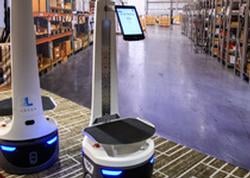
DHL Supply Chain invests $300M to accelerate integration of emerging technologies
DHL Supply Chain, a global provider in contract logistics and part of Deutsche Post DHL Group, has announced plans to deploy emerging technologies in 350 of its 430 facilities in North American facilities and transportation control towers as part of a $300 million investment. Selected technologies will vary by customer needs, based on the outcomes of research and pilot programs completed by DHL’s internal innovation teams and collaboration with dozens of external innovators.
The availability – and practical utilization – of these technologies is expected to help the diverse customer base including those addressing e-commerce and omnichannel challenges to minimize complexity, remove capacity constraints, and maximize service to their customers. Accelerating the implementation of selected technologies such as robotics, augmented reality, robotics process automation, IoT and DHL’s proprietary end-to-end visibility solution – MySupplyChain – is the objective of DHL Supply Chain’s global digitalization strategy.
DHL Supply Chain North America CEO Scott Sureddin said, “This investment is about a holistic view of emerging technologies that enables our customers to achieve their growth and profitability goals. Our customers’ needs are not homogenous as each business and segment has unique challenges and levels of maturity. Therefore, it is important that our customers can benefit from our experiences and expertise with a variety of emerging technologies.”
According to a recent DHL report , the exponential growth of e-commerce and its implications on service was identified by 65 percent of responding companies as having a significant impact on their supply chain. Executives are turning to technology in support of faster delivery times to efficiently manage fluctuating demand. In alignment with this trend, DHL is already leveraging emerging technologies at approximately 85 of its 430 North American facilities.
, the exponential growth of e-commerce and its implications on service was identified by 65 percent of responding companies as having a significant impact on their supply chain. Executives are turning to technology in support of faster delivery times to efficiently manage fluctuating demand. In alignment with this trend, DHL is already leveraging emerging technologies at approximately 85 of its 430 North American facilities.
“While many technologies are already in active deployment, collaborative piece-picking robots, artificial intelligence applications and self-driving vehicles stand to have the most promise today,” added Sureddin. The potential impact on customers’ businesses, which in some deployments have produced productivity gains upwards of 25% and throughput capacity gains of 30%, are two of the main drivers for accelerated investment in the coming years. DHL’s experience with these technologies stands to minimize infrastructure costs and maximize service levels.
Another motivation is based on the workforce itself, which is widely regarded as one of the most significant challenges facing the logistics industry. Technology is one of the many levers DHL is utilizing to attract and retain its team.
Tim Sprosty, Senior Vice President of Human Resources at DHL Supply Chain, said, “These technologies enhance the value of our people; they don’t replace them. Our team will be equipped with the most advanced technologies, trained on emerging ones and retained through a culture of innovation, collaboration and recognition. We believe this approach is a winning strategy not just for our business but for our customers’ businesses as well.”
Earlier this year, DHL broke ground on its Americas Innovation Center that will exhibit the technologies and innovations the business is already implementing across the region. The facility is intended to foster the development of future logistics and supply chain solutions while serving as a regional platform for collaborative innovation. The 24,000-square-foot innovation center, which is located just outside Chicago, is scheduled to open next year.









